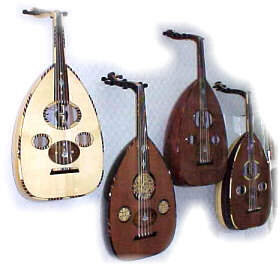The Oud
The oud is a stringed musical instrument prominent in medieval and modern
Islamic music the parent of the European lute. The oud is know in Turkey
as the Lanta and in the Balkans as the oud or uti. The Kuwitra;a longer
necked, narrower variety, is common in North Africa. The oud appeared in
medieval Persia as the"barbat" in the 7th century AD. It's name oud(Arabic:piece
of woods)refers to its aloe wood belly, in contrast tothe skin bellies
of earlier Lutes.Originally, it had a tapered body of one pice with a neck
and two crescent-shaped round holes, much like someEast Asian Lutes, suggesting
a common West Asian origin. In andalusia during the muslim occupation of
spain (711-1492)the present from probably emerged, with a separate neck
and round sound hole with a wooden rose(three sound holes are now commnon).Some
medieval theorists mention the frets of the oud when discussing the proper
note intervals of the 'maqamat' or melodic modes. Surviving pictures of
the oud show no frets, but it is possible that fretted and unfretted types
were used.


